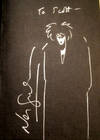
Historia Academiae Fridericianae Erlangensis qua praeter eius originem solemnia dedicationis sacra eventusqve proxime secuti referuntur. Addita sunt scripta tam publica quam privata academiae causa concepta
by GADENDAM, Johann Wilhelm, ed. (1709-1771)
- Used
- first
- Condition
- Good+
- Seller
-
Woodside, New York City, New York, United States
Payment Methods Accepted
About This Item
THE FOUNDATION OF THE UNIVERSITY OF ERLANGEN
Two parts in one volume, folio (335x215 mm). [6], 54, [2] pp.; [2], 217 [recte 219], [3] pp. With several errors in pagination. Collation: [π]3 A-O2; 2[π]1 (A)-(Z)2 (Aa)-(Zz)2 (Aaa)-(Kkk)2. With a folding allegorical frontispiece within a baroque cartouche and 6 plates (4 folding), showing a mezzotint portrait of Margrave Friedrich III, a city map of Erlangen, the ceremonial entry of the founders, the university building, the portrait of the first chancellor Daniel de Superville, and commemorative medallions. Also with several engraved illustrations in text depicting coats of arms and coins. The plates are engraved by Georg Paul Nusbiegel, Christian Fritzsch, Tobias Lobeck, Franz Michael Regenfuss, and Andreas Nunzer after Gottfried Eichler and R.H. Richter. Latin text in roman types and German text in gothic types. Encomium by Johann Wilhelm Gadendam. Last leaf of part one reads: Additamenta Historiam Fridericianae Erlangensis illustrantia et probantia tam publica quam privata quorum seriem versa indicat pagina. Half title of part two: Oratio ordinandae Fridericianae causa inter ipsa dedicationis solemnia recitata IIII. Nov. cIoIoCCXXXXIII. Contemporary half vellum, panels covered with colored paper, red edges (spine restored, slighlty worn and rubbed). Engraved bookplate "Bibliotheca Henrici Jacobi Ledermüller Norimbergensis" on the front pastedown, manuscript ownership entry "Ch.F. Sommer" on the front flyleaf. Some light browning and foxing, marginal repaired tear to one plate without loss, all in all a very good, genuine copy with wide margins.
First edition, dedicated to the Margrave Friedrich III of Brandenburg-Bayreuth (1711-1763), of this nicely illustrated commemorative publication for the opening of the University of Erlangen.
On April 13, 1743, Margrave Friedrich III, who reigned between 1735 and 1763, signed the foundation charter for a new university in his principality after Emperor Charles VII (1697-1745) had issued the necessary privilege on February 21, 1743. After the universities of Altdorf and Würzburg, this was the third university in the Franconian Imperial District. An academy had already been founded in the royal seat of Bayreuth in 1742, but was now closed. Disputes between academy students and members of the military prompted Margrave Friedrich to relocate the newly-founded university to the secondary residence town of Erlangen. The town of Erlangen offered suitable premises (the building of a former knights' academy became the university main seat) and a more favorable cost of living than the royal seat of Bayreuth.
Established in the spirit of the so-called enlightened absolutism, the university had to serve the needs of the state and, in particular, ensure the education of Protestant clergymen, lawyers, doctors, and administrators. University foundations in Halle (Saxony-Anhalt) in 1694 and Göttingen (Lower Saxony) in 1737 served as a model. Margrave Friedrich was supported in his project by his wife, the art-loving and science-interested Margravine Wilhelmine (1709-1758), who was in contact with many important figures of the Enlightenment, such as the philosopher Voltaire (1694-1778).
A formative figure in the initial phase of the university was the margrave's personal physician Daniel de Superville (1696-1773), who was appointed as the university's first chancellor. The opening of the "Friedrichs-Universität" took place on November 4, 1743, the anniversary of which has since been celebrated as "dies academicus".
From the outset, the University of Erlangen was a full university with the right to award doctorates in all four faculties of theology, law, medicine and philosophy, and was initially one of the smaller institutions of its kind. After 64 students enrolled at the new university in its founding year, the average total number of students stabilized at around 200 and 16 full professorships were established at the university. Margrave Friedrich endowed his new foundation with funds, and his first donation was followed by numerous others by margraves and countesses, as well as publishers, noblemen and politicians. Donations included sums of money, art collections, real estate and above all book collections. The university library, which became the university's treasury, was a particularly frequent recipient of donations. Despite that, in the first decades of its existence the university faced major existential problems due to a lack of funding (cf. H.O. Keunecke, Mäzenatentum und Stiftungen an der Friedrich-Alexander-Universität Erlangen-Nürnberg 1743-1810, Nürnberg, 2007).
After the extinction of the Bayreuth line, the Margraviate was ruled from 1769 in personal union with the Principality of Brandenburg-Ansbach under Margrave Karl Alexander (1736-1806). In honor of the now ruling margrave, who was to become its new great patron, the university was renamed Friedrich-Alexander University in the same year and its financial situation significantly improved. Despite having taken advantage economically from the presence of the new university and being home to a Hohenzollern residence, margravial Erlangen, with its 7,724 inhabitants (1774), was only a secondary location and had no political or cultural institutions with any significance beyond the state borders. The professors enjoyed a high level of social prestige in the local urban society. Although the university had not been able to make a name for itself for long, there were already a number of professors with a trans-regional academic reputation at the end of the 18th century, such as the lawyer Christian Friedrich von Glück (1755-1831) and the botanist Johann Christian Daniel von Schreber (1739-1810). With the transfer of Erlangen to Prussia in 1792, to France in 1806 and finally to Bavaria in 1810, the development of the small margravial university into a modern educational institution began. In 1961, the Nuremberg School of Economics and Social Sciences was incorporated; since then, the university has been known as "Erlangen-Nuremberg" (cf. A. Wendehorst, Geschichte der Friedrich-Alexander-Universität Erlangen-Nürnberg 1743-1993, Munich, 1993).
The historian and jurist Johann Wilhelm Gadendam was born in Lauenburg in 1709. He was professor of law in Kiel, Bayreuth, and Erlangen. He was also rector at the Christian-Albrechts-Universität in Kiel in 1766 and 1770. He died in Kiel in 1771.
We offer together four publications loosely contained in the volume: 1. a decree issued on August 19th, 1743 by Margrave Friedrich III of Brandenburg-Bayreuth granting funds and privileges to his newly-founded university (350x215 mm, [2] ll., with the margravial arms on top and a large intial); 2. Memoriam bis saecularem pacis religiosae in comitiis Augustanis […] celebrandam civibus academicis indicit Academiae Fridericiane Erlangensis prorector D. Henricus Fridericus Delius […] Erlangen, J.D.M. Camerarius, [1755] (350x215 mm, [2] ll.); 3. Ad solemnia D. XVII. Maii MDCCLX qui die Serenissimus Princeps ac Dominus Dominus Fridericus Margravius Brandeburgicus […] Academiae Fridericianae Erlangenis Rector Magnificentissumus […] ingreditur instituenda […] Erlangen, J.D.M. Camerarius, [1760] (372x215 mm, [2] ll.); 4: Auspicatissimum Natalem Serenissimae Principis ac Dominae Dominae Sophiae Carolinae Marggraviae Brandenburgicae […] solemni ritu celebrandum Academiae Fridericianae Erlangensis […] Erlangen, J.D.M. Camerarius, [1760] (345x215 mm, [2] ll. with the margravial seal at the bottom of the last page).
VD18, 10417524; OCLC, 1283593617; Erman-Horn, II, 2984; J.W. Gadendam, Historia Academiae Fridericianae Erlangensis. Geschichte der Friedrichs-Akademie zu Erlangen. Herausgegeben von Johann Wilhelm Gadendam anläßlich der Gründung der Universität im Jahr 1743, facsimile edition, Nürnberg, Universitätsbund Erlangen-Nürnberg, 1993; H.O. Keunecke, Bibliographie zur Geschichte der Friedrich-Alexander-Universität Erlangen-Nürnberg, Nürnberg, 1993, p. 36, no. 236.
Reviews
(Log in or Create an Account first!)
Details
- Bookseller
- Govi Rare Books LLC
(US)
- Bookseller's Inventory #
- 182
- Title
- Historia Academiae Fridericianae Erlangensis qua praeter eius originem solemnia dedicationis sacra eventusqve proxime secuti referuntur. Addita sunt scripta tam publica quam privata academiae causa concepta
- Author
- GADENDAM, Johann Wilhelm, ed. (1709-1771)
- Book Condition
- Used - Good+
- Quantity Available
- 1
- Publisher
- Typographia Academica
- Place of Publication
- Erlangen
- Date Published
- 1744
- Weight
- 0.00 lbs
- Keywords
- Festival book, Universities, education, statutes
Terms of Sale
Govi Rare Books LLC
About the Seller
Govi Rare Books LLC
About Govi Rare Books LLC
Glossary
Some terminology that may be used in this description includes:
- Bookplate
- Highly sought after by some collectors, a book plate is an inscribed or decorative device that identifies the owner, or former...
- Facsimile
- An exact copy of an original work. In books, it refers to a copy or reproduction, as accurate as possible, of an original...
- Vellum
- Vellum is a sheet of specialty prepared skin of lamb, calf, or goat kid used for binding a book or for printing and writing. ...
- Half Title
- The blank front page which appears just prior to the title page, and typically contains only the title of the book, although, at...
- Folio
- A folio usually indicates a large book size of 15" in height or larger when used in the context of a book description. Further,...
- New
- A new book is a book previously not circulated to a buyer. Although a new book is typically free of any faults or defects, "new"...
- Edges
- The collective of the top, fore and bottom edges of the text block of the book, being that part of the edges of the pages of a...
- Plate
- Full page illustration or photograph. Plates are printed separately from the text of the book, and bound in at production. I.e.,...










